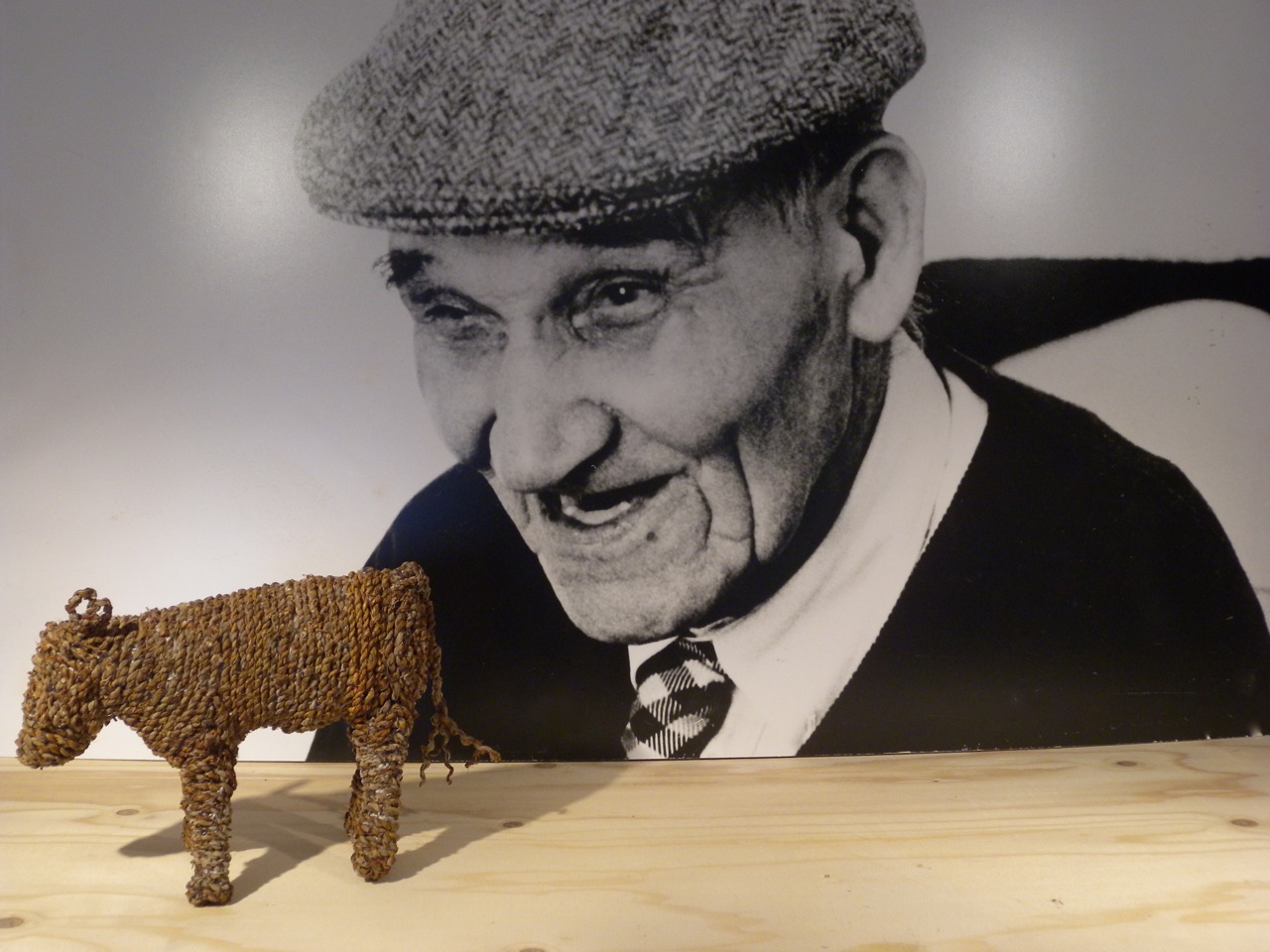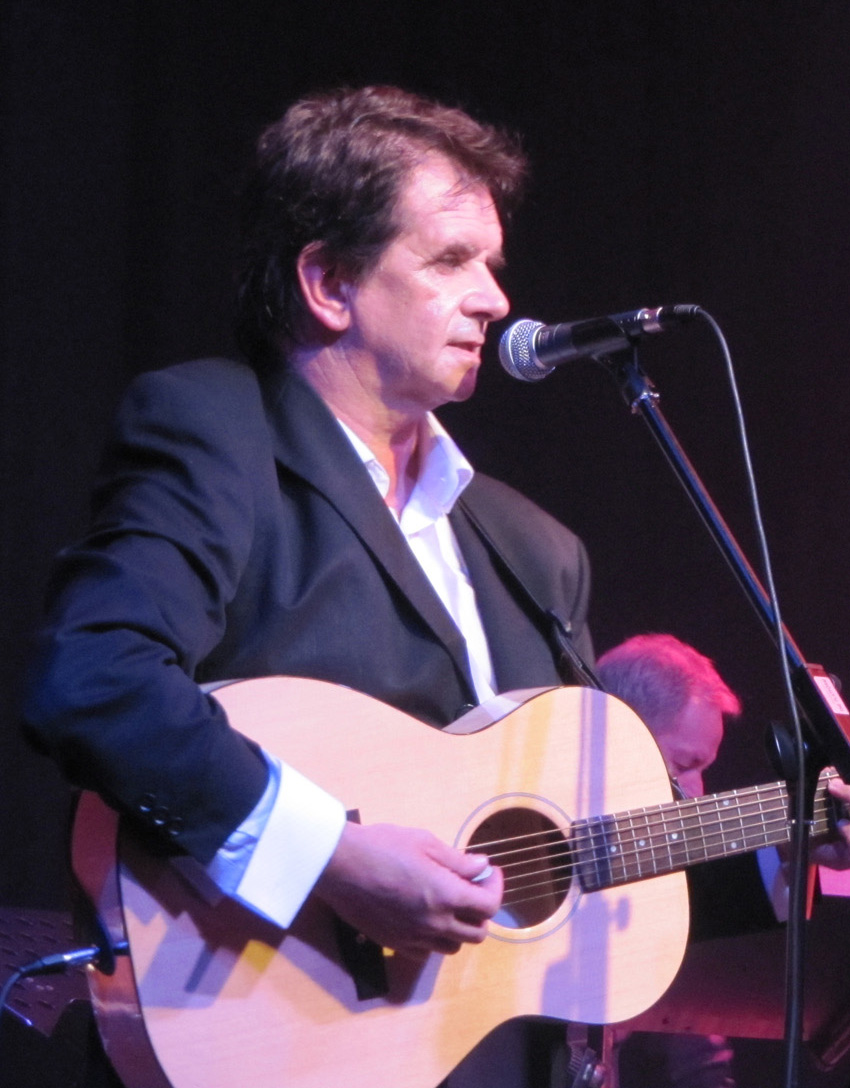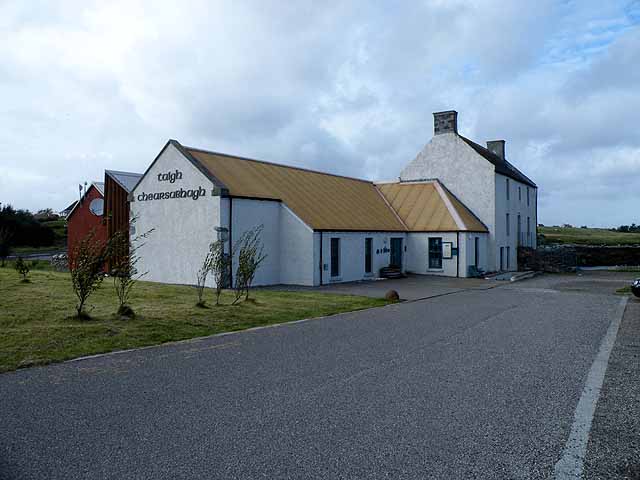|
Angus McPhee
Angus McPhee or MacPhee (1916–1997) was a Scottish Outsider Artist, who lived as a young man in the community of Eochar (Sc.Gaelic: Iochdar) on the island of South Uist, part of the Outer Hebrides. He made his art by weaving found vegetation, such as grasses, into extraordinary garments. He also used sheep's wool picked from barbed wire fences, and leaves. MacPhee created most of his work whilst in the Craig Dunain Hospital near Inverness. He chose not to speak for 50 years. Biography MacPhee was born into a crofting family from Eochar/Iochdar, South Uist ( Outer Hebrides), although he was actually born in Nettlehole, west of Glasgow, whilst his father worked as a hired hand before returning to Uist to settle when Angus was 7. As a young boy on the croft, he learnt how to make ropes and horse-harness from the abundant marram grass or muirineach on the island. He showed some skills playing music and singing, loved horses, but otherwise appeared to be a normal child of a p ... [...More Info...] [...Related Items...] OR: [Wikipedia] [Google] [Baidu] |
Angus And Calf
Angus may refer to: Media * ''Angus'' (film), a 1995 film * ''Angus Og'' (comics), in the ''Daily Record'' Places Australia * Angus, New South Wales Canada * Angus, Ontario, a community in Essa, Ontario * East Angus, Quebec Scotland * Angus, Scotland, a traditional county of Scotland and modern council area * Angus (Scottish Parliament constituency) * Angus (UK Parliament constituency) United States * Angus, Iowa * Angus, Nebraska * Angus, Ohio * Angus, Texas * Angus, Wisconsin * Angus Township, Polk County, Minnesota People Historical figures * Óengus I of the Picts (died 761), king of the Picts * Óengus of Tallaght (died 824), Irish bishop, reformer and writer * Óengus II of the Picts (died 834), king of the Picts * Óengus mac Óengusa (died 930), Irish poet * Óengus of Moray (died 1130), last King of Moray * Aonghus Mór (died 1293), chief of Clann Domhnaill * Aonghus Óg of Islay (died 1314×1318/c.1330), chief of Clann Domhnaill * Aonghas Óg (died 1490), chie ... [...More Info...] [...Related Items...] OR: [Wikipedia] [Google] [Baidu] |
Art Therapy
Art therapy (not to be confused with ''arts therapy'', which includes other creative therapies such as drama therapy and music therapy) is a distinct discipline that incorporates creative methods of expression through visual art media. Art therapy, as a creative arts therapy profession, originated in the fields of art and psychotherapy and may vary in definition. There are three main ways that art therapy is employed. The first one is called analytic art therapy. Analytic art therapy is based on the theories that come from analytical psychology, and in more cases, psychoanalysis. Analytic art therapy focuses on the client, the therapist, and the ideas that are transferred between the both of them through art. Another way that art therapy is utilized is art psychotherapy. This approach focuses more on the psychotherapist and their analysis of their clients' artwork verbally. The last way art therapy is looked at is through the lens of art as therapy. Some art therapists practicing ... [...More Info...] [...Related Items...] OR: [Wikipedia] [Google] [Baidu] |
Joanne B Kaar
{{disambiguation ...
Joanne may refer to: Music * ''Joanne'' (album), 2016 album by Lady Gaga ** "Joanne" (Lady Gaga song), a 2016 song from the album ''Joanne'' * "Joanne" (Michael Nesmith song), a 1970 song from the album ''Magnetic South'' * "Joanne", a song by Cherry Ghost from the 2014 album ''Herd Runners'' Other uses * Joanne (given name) * Joanne (''Coronation Street''), a character from the British television soap opera ''Coronation Street'' *JoAnne's Bed and Back, defunct U.S. furniture retailer See also * Jo-Ann (other) * * Joanna (other) * Joannes (died 425), western Roman emperor * Jehanne (other) * Jeanne (other) * Joan (other) Joan may refer to: People and fictional characters *Joan (given name), including a list of women, men and fictional characters *:Joan of Arc, a French military heroine *Joan (surname) Weather events *Tropical Storm Joan (other), multiple ... [...More Info...] [...Related Items...] OR: [Wikipedia] [Google] [Baidu] |
Horse And Bamboo Theatre
Horse and Bamboo Theatre or Horse + Bamboo Theatre is a British theatre company founded in 1978 by Bob Frith. The company works using masks and visual, puppet, physical, music-based forms rather than text. It works internationally as well as from The Boo in Waterfoot, Rossendale, Lancashire, UK. Since 2012 the emphasis of its work has been increasingly in serving its local community, and much of its work was under 'The Boo' name, until the venue was ‘de-branded’ to ‘Horse and Bamboo’ in 2022. Origins Frith taught in the early 1970s at Manchester School of Art (later Manchester Metropolitan University). Unhappy with the prevailing abstraction of the period he experimented with extending purely visual forms to include live performance and music, influenced by Allan Kaprow, Red Grooms and Claes Oldenburg, and working with groups of his students. At the Bede Gallery, Jarrow, he worked on a large-scale project with his friend Dave Pearson, filmmakers and artists, and inclu ... [...More Info...] [...Related Items...] OR: [Wikipedia] [Google] [Baidu] |
Roger Hutchinson (writer)
Roger Hutchinson (born 1949) is a British author and journalist. Hutchinson was born at Farnworth, near Bolton, in Lancashire, but lives on Raasay, off the east coast of Skye. Education Hutchinson attended Bretton Hall College in Leeds to study English. Career In the late 1960s, around the time he studied English at Bretton Hall College, he founded and edited 'Sad Traffic', published from a small office in Barnsley, which ran for five issues before morphing into Yorkshire's alternative newspaper, Styng (Sad Traffic Yorkshire News & Gossip). He then moved to London and edited '' OZ'', '' International Times'' and the magazine '' Time Out''. In the late 1970s Hutchinson moved to Skye to become a journalist on the ''West Highland Free Press''. Since 1999 he has lived on Raasay. He has also served as editor of the '' Stornoway Gazette''. Books As of 2017, Hutchinson has written 15 non-fiction books. ''Polly, The True Story Behind Whisky Galore'' (1990) was about the SS ''P ... [...More Info...] [...Related Items...] OR: [Wikipedia] [Google] [Baidu] |
Runrig
Runrig were a Scottish Celtic rock band formed on the Isle of Skye in 1973. From its inception, the band's line-up included songwriters Rory Macdonald and Calum Macdonald. The line-up during most of the 1980s and 1990s (the band's most successful period) also included Donnie Munro, Malcolm Jones, Iain Bayne, and Pete Wishart. Munro left the band in 1997 to pursue a career in politics and was replaced by Bruce Guthro. Wishart left in 2001 and was replaced by Brian Hurren. The band released fourteen studio albums, with a number of their songs sung in Scottish Gaelic. Initially formed as a three-piece dance band known as 'The Run Rig Dance Band', the band played several low key events, and has previously cited a ceilidh at Kelvin Hall, Glasgow as their first concert. Runrig's music is often described as a blend of folk and rock music, with the band's lyrics often focusing upon locations, history, politics, and people that are unique to Scotland. Songs also make references to ... [...More Info...] [...Related Items...] OR: [Wikipedia] [Google] [Baidu] |
Donnie Munro
Donnie Munro (Scottish Gaelic: Donaidh Rothach /dɔnɪ rɔhəx/) (born 2 August 1953) is a Scottish musician, and former lead singer of the band Runrig. A native speaker of Scots Gaelic, much of his work is in that language. Early life Munro was born in Uig, Isle of Skye in the Inner Hebrides. He attended Gray's School of Art in Aberdeen and earned a postgraduate degree in teaching at Moray House in Edinburgh. Music career He first saw Runrig play in 1973 and was approached one year later to become a member of the band. As lead singer of Runrig, Munro became established as a Gaelic music performer of the 1980s and 1990s. Munro left Runrig in 1997 to pursue a career in politics. His final performance was a farewell concert at Stirling Castle on 29 August. Munro released a solo album, ''Heart of America'', done in collaboration with fellow Skye songwriters Blair Douglas and Richard Macintyre, and won Album of the Year in the Scottish TradMusic Awards 2006. He continues to w ... [...More Info...] [...Related Items...] OR: [Wikipedia] [Google] [Baidu] |
Angus McPhee Woven Grass Jacket
Angus may refer to: Media * ''Angus'' (film), a 1995 film * ''Angus Og'' (comics), in the ''Daily Record'' Places Australia * Angus, New South Wales Canada * Angus, Ontario, a community in Essa, Ontario * East Angus, Quebec Scotland * Angus, Scotland, a traditional county of Scotland and modern council area * Angus (Scottish Parliament constituency) * Angus (UK Parliament constituency) United States * Angus, Iowa * Angus, Nebraska * Angus, Ohio * Angus, Texas * Angus, Wisconsin * Angus Township, Polk County, Minnesota People Historical figures * Óengus I of the Picts (died 761), king of the Picts * Óengus of Tallaght (died 824), Irish bishop, reformer and writer * Óengus II of the Picts (died 834), king of the Picts * Óengus mac Óengusa (died 930), Irish poet * Óengus of Moray (died 1130), last King of Moray * Aonghus Mór (died 1293), chief of Clann Domhnaill * Aonghus Óg of Islay (died 1314×1318/c.1330), chief of Clann Domhnaill * Aonghas Óg (died 1490), chie ... [...More Info...] [...Related Items...] OR: [Wikipedia] [Google] [Baidu] |
Lochmaddy
Lochmaddy ( gd, Loch nam Madadh, "Loch of the Hounds") is the administrative centre of North Uist in the Outer Hebrides, Scotland. ''Na Madaidhean'' (the wolves/hounds) are rocks in the bay after which the loch, and subsequently the village, are named. Lochmaddy is within the parish of North Uist. Geography Lochmaddy lies on the sea loch of that name and, due to the rocky nature of the coast, is the only settlement of any size on the east coast. Most of the island's settlements are on the west coast. Lochmaddy is at the eastern end of the A865 and close to the eastern end of the A867; these are the only two main roads on the island. History Virtually the first mention anywhere of Lochmaddy is a complaint of "piracie and murder" in a report dated 1616: "Lochmaldie on the coast of Uist is a rendezvous for pirates" it said. The coves and inlets around the village were ideal hiding places for raiding ships stocked with fine goods bound for the clan chiefs of the time, and contraba ... [...More Info...] [...Related Items...] OR: [Wikipedia] [Google] [Baidu] |
Taigh Chearsabhagh
Taigh Chearsabhagh is an arts centre and museum in Lochmaddy on the island of North Uist, Scotland. Taigh Chearsabhagh was built in 1741 and originally used as an inn; it has since served as a post office, house and workshop before being developed as an arts centre since 1993. It is the base for the art school of Lews Castle College, part of the University of the Highlands and Islands, where students can study for NC Art and Design or a BA (Hons) in Fine Art, or take short courses. In 2022 it was a venue for Simon Armitage Simon Robert Armitage (born 26 May 1963) is an English poet, playwright, musician and novelist. He was appointed Poet Laureate on 10 May 2019. He is professor of poetry at the University of Leeds. He has published over 20 collections of poetr ...'s Poet Laureate's Library Tour. References External links * North Uist Arts centres in Scotland University of the Highlands and Islands Museums in the Outer Hebrides {{WesternIsles-geo-stub ... [...More Info...] [...Related Items...] OR: [Wikipedia] [Google] [Baidu] |
Pittenweem
Pittenweem ( ) is a fishing village and civil parish in Fife, on the east coast of Scotland. At the 2001 census, it had a population of 1,747. Etymology The name derives from Pictish and Scottish Gaelic. "Pit-" represents Pictish ''pett'' 'place, portion of land', and "-enweem" is Gaelic ''na h-Uaimh'', 'of the Caves' in Gaelic, so "The Place of the Caves". The name is rendered ''Baile na h-Uaimh'' in modern Gaelic, with ''baile'', 'town, settlement', substituted for the Pictish prefix. The cave in question is almost certainly St Fillan's cave. History The settlement has existed as a fishing village since early medieval times. The oldest structure, St. Fillan's Cave, dates from the 7th century. An Augustinian priory moved here from the Isle of May in the 13th century, but there was already a church at that time. Pittenweem Parish Church (which is attached to the local tolbooth) has a Norman doorway dating to before 1200. The gatehouse to the east is 15th century. The priory ... [...More Info...] [...Related Items...] OR: [Wikipedia] [Google] [Baidu] |





